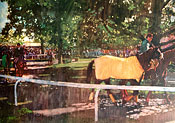Bernie Fuchs – “Caravaggio in Car Ads” – 1991 Sport Artist of the Year
Artist Biography | Style & Inspiration | Key Sport Works & World Influence

Belmont (Paddack)
At the time when Fuchs was celebrating immense success in the illustration field, the profession of illustrator was quickly becoming endangered. Photography was creeping up as the premier avenue for advertising and “illustration.” Yet Fuchs was never threatened by photographs. His creativity and drive to remain at the top of his field led to a unique approach to integrating and adapting photography into his art. “It doesn’t really matter whether an assignment is done by the artist or by the camera,” Fuchs said. “The point is, is the story illustrated right?”
Fuchs typically began his illustrations with photographs—often his own—and then projected them on canvas. With careful cropping and frequent diagonals in his compositions, he created a legacy of the form. For Fuchs, there was little distinction between fine art and his illustrations. “I’m making pictures. I don’t differentiate,” he said. The American Sport Art Museum and Archives (ASAMA) recognized Fuchs’s impact on the sport art world and honored him as 1991 Sport Artist of the Year.

Old Fashioned Race Cars (Indy 500)
Borrowing from Degas’s horizontal compositions and compositions from master photographer Henri Cartier-Bresson, Fuchs has worked with casein, acrylics, watercolor, pen-and-ink, and other mixed media. His favorite medium, however, is oils. Oils proved to be the best way to capture the impressionistic varied use of light with which the artist was so fascinated. But, he came to like oils by accident.
While working on an assignment forLithopinion magazine, Fuchs was painting English pubs and wanted to capture the amber color of a mug of ale with the sunlight behind it. He tackled the assignment with oils, but was displeased with the result. When Fuchs wiped the oil paint off with a rag, the resulting color was exactly what he had imagined.
Thus, Fuchs began creating the variations of color from light by wiping out oil paints with a brush or cloth dipped in turpentine. Because of the experience, many of Fuchs’s painting have an amber glow with varying temperatures of orange, red, or green. “Painting is not about color but about value. This is one of the best lessons I ever learned,” he said.
Part of Fuchs’s success can be attributed to his ability to adapt. A renowned illustrator, Robert Heindel, said, “Bernie’s brilliance was that he could take the same assignment that everyone else got and do something special with it.” But for Fuchs, adaptation was simple. He said, “Today’s editorial people look for the guy they know will do something he hasn’t done before… If a job you do reverts to what you were doing two years ago, then, I think, you’re in real trouble.”
Walt Reed said Fuchs’s “pictures are probably more admired—and more imitated—than those of any other current illustrator.” His impact on art can still be felt today, and while he may not have been able to hit the high “C” on the trumpet, Fuchs was able to hit unparalleled highs in illustration and the sports art community.
image sources
- Fuchs-feature: Bernie Fuchs

